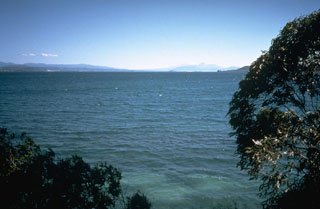Report on Taupo (New Zealand) — 21 September-27 September 2022
Smithsonian Institution / US Geological Survey
Weekly Volcanic Activity Report, 21 September-27 September 2022
Managing Editor: Sally Sennert.
Please cite this report as:
Global Volcanism Program, 2022. Report on Taupo (New Zealand) (Sennert, S, ed.). Weekly Volcanic Activity Report, 21 September-27 September 2022. Smithsonian Institution and US Geological Survey.
Taupo
New Zealand
38.7811°S, 175.893°E; summit elev. 760 m
All times are local (unless otherwise noted)
On 28 September GeoNet reported that seismic unrest and deformation at Taupo continued during the previous week. About 750 earthquakes have been located at depths of 4-13 km beneath the lake since unrest began in May. During the past week the locations were concentrated beneath the E part of the lake and occurred at a slightly lower rate than the week before. An area of deformation at Horomatangi Reef had been rising at a rate of 60 mm (plus or minus 20 mm) per year since May. The data suggested that the seismicity and deformation was caused by the movement of magma and hydrothermal fluids. GeoNet noted that unrest at calderas was common and may continue for months or years without resulting in an eruption; more significant unrest would be indicated by additional indicators of activity and substantial impacts on the local area. The Volcanic Alert Level remained at 1 (the second lowest level on a six-level scale) reflecting “minor volcanic unrest” characterized by ongoing seismicity and inflation.
Geological Summary. Taupo, the most active rhyolitic volcano of the Taupo volcanic zone, is a large, roughly 35-km-wide caldera with poorly defined margins. It is a type example of an "inverse volcano" that slopes inward towards the most recent vent location. The caldera, now filled by Lake Taupo, largely formed as a result of the voluminous eruption of the Oruanui Tephra about 22,600 years before present (BP). This was the largest known eruption at Taupo, producing about 1,170 km3 of tephra. This eruption was preceded during the late Pleistocene by the eruption of a large number of rhyolitic lava domes north of Lake Taupo. Large explosive eruptions have occurred frequently during the Holocene from many vents within Lake Taupo and near its margins. The most recent major eruption took place about 1,800 years BP from at least three vents along a NE-SW-trending fissure centered on the Horomotangi Reefs. This extremely violent eruption was New Zealand's largest during the Holocene and produced the thin but widespread phreatoplinian Taupo Ignimbrite, which covered 20,000 km2 of North Island.
Source: GeoNet

